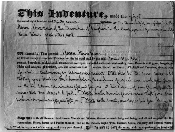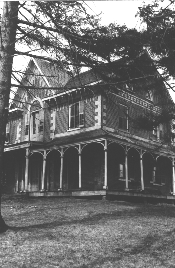Aftermath of
Rebellion
As Mackenzie's men fled from the battlefield on December
7, 1837, they were helped by the usual deplorable state of
Yonge Street. "The
road was in such bad condition," writes one historian, that "pursuit of the
rebels after the battle of
Montgomery's
Farm was almost impossible - even on horseback."
33Mackenzie
himself and a number of his sympathizers were thus able to escape to the United
States.
 |
| Highland
Cottage,86 Major
Mackenzie Drive, dating from the 1840s. |
Still, many of Mackenzie's followers were captured and
imprisoned in the days following the collapse of the uprising, as loyalists
rallied and sought revenge.
Samuel Lount and
Peter Matthews
were convicted of treason and hanged for their part in the uprising; others
were "transported," or exiled, to Australia; most were released after a short
time in jail.
Mackenzie
and those living in American exile eventually returned to Upper Canada after
political tensions eased.
 |
| Tomb of
Colonel Moodie
in
Trinity
churchyard, Thornhill.A.J. Clark |
But it took some time for those tensions to abate. On
Tuesday, October 15, 1838, a meeting was held in
Richmond Hill where
the farmers and settlers of
Vaughan and
Markham discussed
recommendations for responsible government prepared by Lord Durham, the
commissioner appointed by Britain to investigate the troubles in the Canadian
colonies. Eighteen-year-old
Larratt Smith, Jr., son of arch-Tories
Captain and
Mary
Smith of
Twickenham Farm,
attended the meeting and recorded his impressions:
 |
| Part of a deed for Lot 51 West
(the
Vaughan
Township side of
Yonge Street),
from
Aaron Munshaw
to
James Newton,
May 6, 1837." |
"The Durham Meeting took place on Tuesday with about 1000
people present.
Mr. Boyd was
Chairman & Papa moved the Resolution,"
young Smith noted in his diary. "Later, a fight broke out
in which the Orangemen thrashed the rebels so badly that one man was killed
almost on the spot. I came home a little after dinner & at nightfall loaded
all our guns & pistols & went round the house before I went to bed."
34
 |
| Observatory
House on
Observatory
Lane, pictured in 1933.
Robert and
Sara
(Bridgeford) Marsh built the older section of the house in the 1840s.
A later addition was erected by their grandson
Alexander in
1866. |
Although there had been many rebel sympathizers in the
Richmond Hill area,
the
Tories maintained control of
the village's political life and its community organizations for the next
several years. The
Home
District Agricultural Society, in which
Mackenzie
had once found supporters, reflected this new order. At a meeting in
Richmond Hill on
December 9, 1840, with the sheriff of the
Home
District in the chair, and members like
Hugh Stewart,Richard
Gapper, and
Edward O'Brien
dominating proceedings, the society went on record as the representative body
of
York County farmers and
landowners.
35
Long after the rebels had been apprehended and put on
trial, and the official meetings had faded into history,
Simon Miller
remembered the lasting divisions within the community.
Miller was an
eleven-year-old
Richmond Hill
schoolboy in December 1837. He heard shots fired, witnessed rebel forces on the
march, and watched as "loads of prisoners" were taken to Toronto to stand
trial. What remained clearest in his mind sixty years later, however, were "the
feuds it gave rise to," which "lasted for a generation." For years afterwards,
Miller recalled, the
first taunt hurled during a quarrel was "You are a rebel" or "the son of a
rebel."
36
Notes
33.
Edwin C. Guillet,Toronto from Trading Post to Great City(Toronto:Ontario Publishing Company,1934),p. 97.
34.
Smith,Young Mr. Smith in Upper Canada,p. 21.
35.
Berchem,The Yonge Street Story,p. 151.
36.
Markham Sun,July 14, 1898.
Previous
Next
Copyright © Richmond Hill Public Library Board, 1991
|

